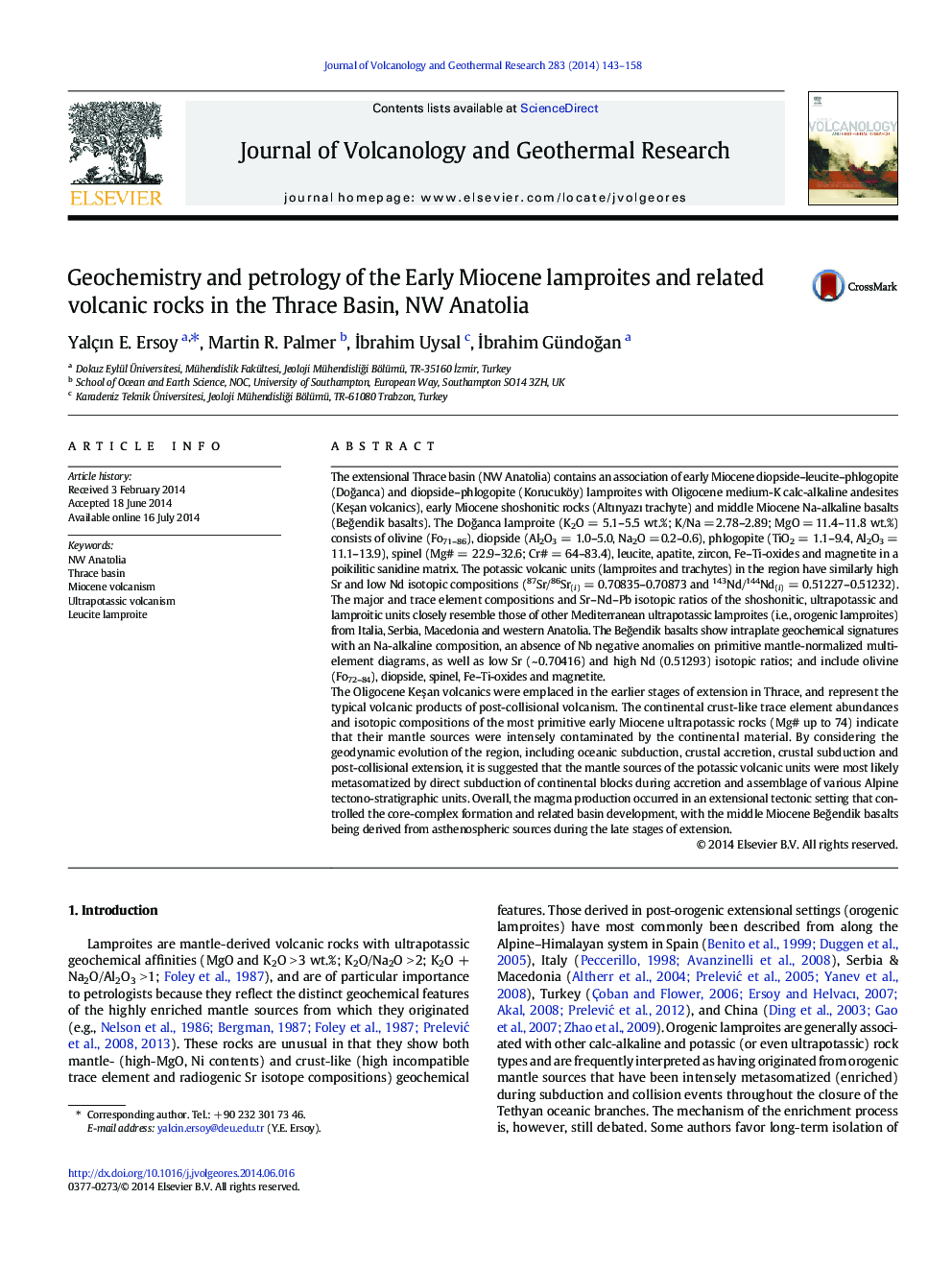| کد مقاله | کد نشریه | سال انتشار | مقاله انگلیسی | نسخه تمام متن |
|---|---|---|---|---|
| 4712375 | 1638339 | 2014 | 16 صفحه PDF | دانلود رایگان |
• Late Cenozoic volcanic rocks in the Thrace basin are studied.
• Volcanics include calc-alkaline to ultrapotassic series and Na-alkaline basalts.
• Ultrapotassic rocks (UK) include leucite-bearing lamproites.
• Mantle metasomatism of the UK rocks can be explained by continental subduction.
The extensional Thrace basin (NW Anatolia) contains an association of early Miocene diopside–leucite–phlogopite (Doğanca) and diopside–phlogopite (Korucuköy) lamproites with Oligocene medium-K calc-alkaline andesites (Keşan volcanics), early Miocene shoshonitic rocks (Altınyazı trachyte) and middle Miocene Na-alkaline basalts (Beğendik basalts). The Doğanca lamproite (K2O = 5.1–5.5 wt.%; K/Na = 2.78–2.89; MgO = 11.4–11.8 wt.%) consists of olivine (Fo71–86), diopside (Al2O3 = 1.0–5.0, Na2O = 0.2–0.6), phlogopite (TiO2 = 1.1–9.4, Al2O3 = 11.1–13.9), spinel (Mg# = 22.9–32.6; Cr# = 64–83.4), leucite, apatite, zircon, Fe–Ti-oxides and magnetite in a poikilitic sanidine matrix. The potassic volcanic units (lamproites and trachytes) in the region have similarly high Sr and low Nd isotopic compositions (87Sr/86Sr(i) = 0.70835–0.70873 and 143Nd/144Nd(i) = 0.51227–0.51232). The major and trace element compositions and Sr–Nd–Pb isotopic ratios of the shoshonitic, ultrapotassic and lamproitic units closely resemble those of other Mediterranean ultrapotassic lamproites (i.e., orogenic lamproites) from Italia, Serbia, Macedonia and western Anatolia. The Beğendik basalts show intraplate geochemical signatures with an Na-alkaline composition, an absence of Nb negative anomalies on primitive mantle-normalized multi-element diagrams, as well as low Sr (~ 0.70416) and high Nd (0.51293) isotopic ratios; and include olivine (Fo72–84), diopside, spinel, Fe–Ti-oxides and magnetite.The Oligocene Keşan volcanics were emplaced in the earlier stages of extension in Thrace, and represent the typical volcanic products of post-collisional volcanism. The continental crust-like trace element abundances and isotopic compositions of the most primitive early Miocene ultrapotassic rocks (Mg# up to 74) indicate that their mantle sources were intensely contaminated by the continental material. By considering the geodynamic evolution of the region, including oceanic subduction, crustal accretion, crustal subduction and post-collisional extension, it is suggested that the mantle sources of the potassic volcanic units were most likely metasomatized by direct subduction of continental blocks during accretion and assemblage of various Alpine tectono-stratigraphic units. Overall, the magma production occurred in an extensional tectonic setting that controlled the core-complex formation and related basin development, with the middle Miocene Beğendik basalts being derived from asthenospheric sources during the late stages of extension.
Journal: Journal of Volcanology and Geothermal Research - Volume 283, 15 August 2014, Pages 143–158
